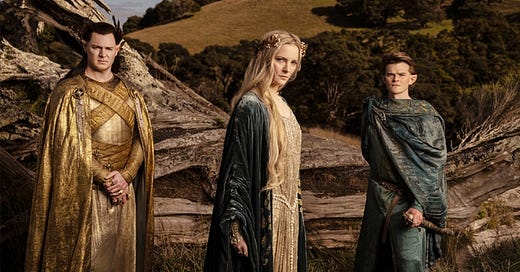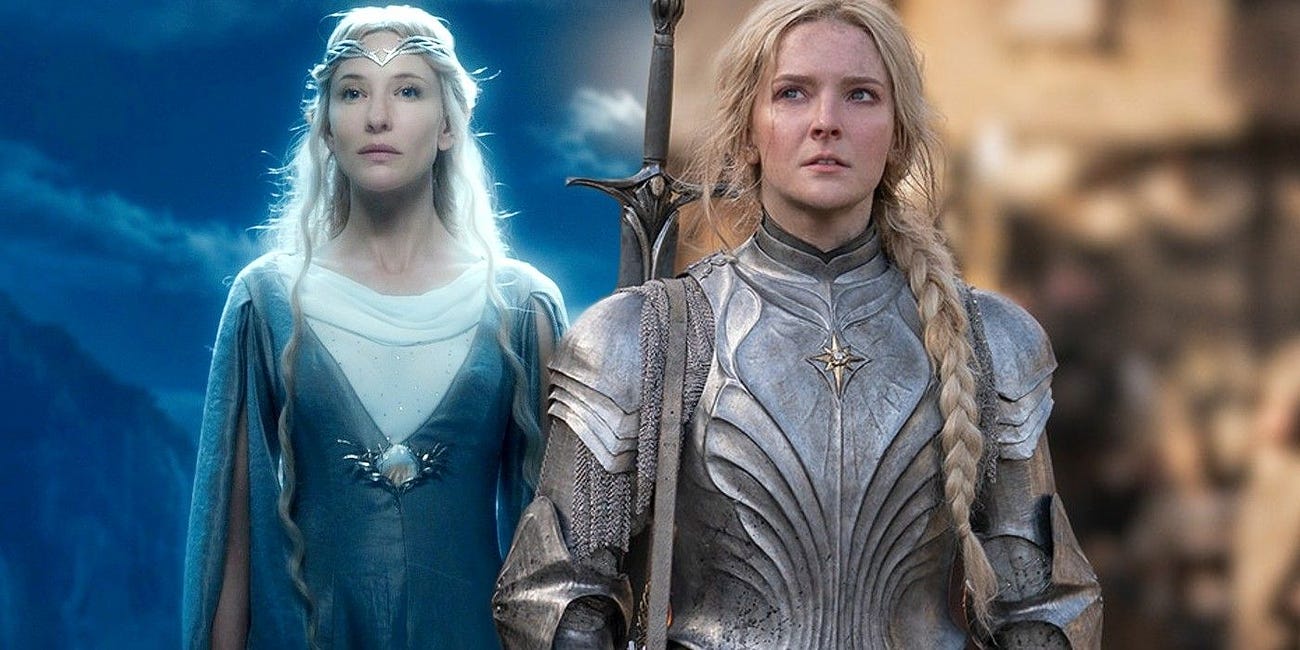Celebrant May the Fourth Be With You!
People And with your Force Ghost.
Happy May the Fourth! I recently finished watching the first season of Andor, and with news of more The Lord of the Rings movies on the way in the near future and more seasons of The Rings of Power on the horizon too, I’ve been thinking a lot about the inherent problems of prequels. What makes a prequel actually work? Because, if we’re honest, not every prequel works as well as others. What’s going on there? Do these factors affect Amazon’s The Lord of the Rings: The Rings of Power? And how does its first season compare with other similar prequels? Where does it stack up well against them? And where it compares unfavorably, is there anything it can it do in future seasons to improve in these areas?
While there are obviously many factors that affect the final quality and success of prequels, in today’s newsletter I’m focusing a few of the factors I’ve personally been considering. And in honor of May the Fourth, I’ll look at The Rings of Power alongside examples from some other recent television prequel series I’ve seen—Kenobi, Andor, and Star Trek: Strange New Worlds—to illustrate my points.
The four major factors that present challenges to any prequel I’ve been mulling over are Pacing the Prequel, Navigating Fidelity to The Source Material, Resisting the Temptation to Overdo Fan-service, and Approaching The Predetermined Fate of Characters. In today’s newsletter, I’ll give an overview of prequels generally and then tackle the first of these factors. Then in next week’s newsletter, I’ll cover the remaining factors and have some concluding thoughts.1
[There will be some light spoilers throughout this series for each show, though I’ll try to limit the major plot revelations for those who haven’t seen them. However, if you’re meaning to watch any of these shows but haven’t gotten around to it, consider this your SPOILER WARNING]
To Prequel, Or Not To Prequel
Seemingly everywhere you look across the current media landscape, studios are chasing the success of the Marvel Cinematic Universe and trying to establish their own cinematic universes and franchises that will churn out Content™ ad infinitum and effectively print an endless supply of dependable money for them. Inevitably, this franchizification involves going back and doing a prequel, or a story depicting events that occur prior to those of an existing work.
Prequels are an attractive proposition for good reason. When you’re making a prequel, you don’t have to start from square one. You already have a universe with history and characters to tap into for story ideas and inspiration. In a prequel you can see familiar characters in a new light during earlier adventures or you can introduce entirely new characters into a familiar world. Prequels provide a chance to fill in the gaps in a story that’s already been told and show how events either referenced in the original story or introduced for the first time in the prequel lead to the original story.2 And—perhaps most crucially from a studio or publisher’s perspective—prequels can provide a reason to return to a favorite world and tap into a pre-established, enthusiastic, and loyal base of fans.
So there’s a lot of upside for both audiences and creators if you get it right. Why don’t prequels always live up to the promise? What are some of the major issues that prequels run into?
It turns out that many of these upsides are double-edged swords. Yes, you already have events and characters to tap into, but you can be limited by these events as easily as you can be inspired. Characters you use from the original can’t die in a prequel, for instance, draining dramatic sequences of some or all of their tension: the character has plot armor.3 Your new characters will also certainly be compared and contrasted with the original characters (whether they appear in your prequel or not) and judged by their standard. And the very fans whose love for the originals you hope to tap into can turn on you if you fail to live up to their sky-high expectations and powerful nostalgia.
How have The Rings of Power, Strange New Worlds, Kenobi, and Andor handled or been hamstrung by these potential pitfalls? Let’s start with number of episodes and episode length.
(continued below)
*Waves Hand* You Want to Become a Jokien With Tolkien Paid Subscriber
Ok, if I had the ability to do a Jedi Mind Trick, it would be completely unethical to force anyone to become a paid subscriber, but maybe you’ve already been thinking about it on your own! Just $5 a month (or $40 annually—that’s $3.33 a month) gets you the past and present monthly essays for paid subscribers and full access to the monthly Book Notes feature. Plus your support goes to a good cause: the continued existence of this newsletter, including more in-depth series like this! Hit the button below to find out more:
Pacing the Prequel
When coming up with a prequel, you have to decide how much story you’re going to attempt to tell and the format that you’re going to tell it in. You already know the ending point of the journey (more on that later), but what route and pace will you take to get there? In television shows, this comes down to number of episodes, episode lengths, and number of seasons. Going to our main examples for this series, in their first seasons, Kenobi had six episodes, The Rings of Power had eight, Strange New Worlds had ten, and Andor had twelve.4
Did ROP end up going too short? Or was this a case where Eight Is Enough? Even though different average episode lengths meant the total number of minutes come out close for The Rings of Power, Strange New Worlds, and Andor,5 both Strange New Worlds and Andor felt better paced. Why? Because having more episodes that were on average more focused and concise came across as deliberate and yet not overstuffed, patient but not boring, and not trying to do too much while still maintaining quality. The Rings of Power, on the other hand, attempted to juggle lengthy storylines involving Galdariel and Halbrand, Númenor, the elves of Lindon and Eregion and the dwarves of Moria, the Southlands, AND the Stranger and the Harfoots all in the course of just eight episodes. This seemed a bit frantic and overstuffed at points, especially before several of these storylines intertwined.
The Rings of Power could have benefited from an extra episode or two or a cut storyline here or there to alleviate some of this feeling of too much going on and not enough space for ideas and plotlines to fully develop. In future seasons, I’d love to see The Rings of Power focus on fewer storylines or have a slightly expanded episode count in order to improve the pacing and flow of the story.
Continue Reading:
Episode II—Fate and Fan Service
Last Week On Jokien with Tolkien I started a two-part series in last week’s newsletter where I gave an overview of prequels generally and outlined four major factors that I have seen present challenges to many prequels: Pacing the Prequel, Approaching The Predetermined Fate of Characters, Resisting the Temptation to Overdo Fan Service, and Navigating Fid…
That’s all for today’s newsletter. Farewell, friends. Go towards goodness!
Special shoutout and thank you to Brian W for upgrading to a paid subscription this week! This is a reader-supported newsletter so if you enjoy these updates each week, please consider supporting this Substack by upgrading to a paid subscription.
Or if you would prefer either a $3 monthly subscription, to subscribe at the normal rate but not via Substack, or to subscribe but chip in a little bit extra each month, check out the different tiers on my new patreon!
Want to support me another way? You can also click the ♡ below, forward this to a friend, or share the link on social media. Every little bit helps!
Appendices
My friend and fellow lover of literature, humor, and joy
is starting a new Substack, . Check it out and give her a subscribe!Have no fear, paid subscribers! Your exclusive essay is still coming this month; it’ll just drop the Thursday after this series wraps up instead of the second Thursday like the pattern has been.
Interested in a paid subscription but legitimately can’t justify the expense right now? Email me at JRRJokien@gmail.com! I have one sponsored annual subscription to gift to the first person who claims it! No questions asked.
All typos are totally on purpose. Links may be affiliate.
That’s the plan, anyways! We’ll see if I can get to all three in next week’s newsletter or if this will become a three-part series.
Specifically for television shows, you also have the opportunity to delve into the world at (potentially) a much greater length compared to the runtime of even the longest of movie trilogies (looking at you, Peter Jackson’s combined runtime of close to 11 1/2 hours for the extended editions of The Lord of the Rings trilogy) to tell your addition to the story.
One of the clear distinctions that has historically separated television and the cinema is the cumulative length of their respective products. For the past twenty-five years or so, the average length worldwide of a feature film that had a domestic theatrical release was between 90 minutes and 120 minutes (via https://stephenfollows.com/are-movies-getting-longer/ ). Compare this with the average American network television show. At 22 episodes a season and often anywhere from five to seven seasons at least, a successful half-hour television series could easily rack up over 50 hours of programming. Movies just can't compete here. Even combining the runtime of every Harry Potter movie results in just short of 20 hours of content.
This extra time compared to movies is an advantage if you can maintain the quality. However, even with teams of writers, shows that run full 22 episode seasons struggle to remain at a consistent quality. Focusing on quality over quantity is one of the factors—such as fewer shows attempting to hit the magic 88 or 100 episode marker to be syndicated—leading to the rise of shorter season lengths for modern streaming shows such as the shows that I’m discussing here.
Unless you have a complicated or implausible—or both!—explanation involving clones, time travel, robot impersonators, mirror universe doubles, etc.
Kenobi is the outlier here, as it was intended as a miniseries and doesn’t seem at this point like it will get a second season.
The 8 ROP episodes ranged from 65–72 minutes each, compared to 46–62 for the 10 SNW episodes and 38–57 for Andor’s 12.











Personally, I kind of hate this short season trend (one exception of Andor, a different beast entirely, which I loved). I think you're absolutely right about ROP. The pacing was uncomfortably and noticeably off. It all felt a little thin--butter scraped over too much bread 😂